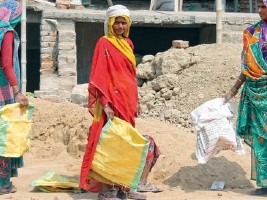Planning for Uncertainity
Today uncertainties associated with climate variability poses great risks to the economic development all over the world. India has reasons to be concerned about climate change. Its large population depends upon climate-sensitive sectors like agriculture and forestry for its livelihood. With the increasing climate variabilities, the livelihood of millions of farmer’s in climate change sensitive agriculture based economy of India is at stake. Today, investing in agriculture and its inputs has turned into a huge gamble. How can the cascading impacts of such unpredictable events on agriculture be avoided? Well, the risks posed by climate change may not be impeded; the losses incurred by it certainly can be minimized by the adoption of risk management and climate change adaptation strategies.
The long-term nature of climate change and the significant impact it can have on Indian agricultural systems requires future agricultural development policy and practices to include both short-term and long-term planning that incorporates climate change knowledge and understanding. This requires embedding adaptation strategies within the existing national policy and institutional framework, enabling integration of climate change issues with other issues that drive the economic and social sectors. We, at Development Alternatives, aim to identify gaps in the current practice-policy links and integrate robust climate resilient adaptation measures into the policy development process for climate smart policies in the country.
Since, climate change may disproportionately affect different sectors of economic development and may hamper the achievement of national and sub national, social, and economic and development goals, it is critical to cope with long term implications of change by incorporating climate smart vision in the development process. Integrating adaptation into policy and planning provides an essential opportunity to make more climate-resilient development investments. It also provides scope for the identification of “no regret” adaptation measures which are beneficial irrespective of climate change implications. Multi cropping, mixed farming and livestock systems, conservation and sustainable use of natural resources are some examples of “no regret” adaptation measures which build resilient livelihoods without impacting climate change.
Successful implementation of climate smart policy also requires climate risk communication as one of the most important tools for climate change adaptation. To facilitate implementation of adaptation measures it is important to communicate appropriate and relevant climate change information to the right audience at the right time. Climate change communication thus forms the backbone of climate change adaptation and adaptive planning. Development Alternatives is making use of traditional (wall paintings, street plays, folk songs, village discussions) and modern mass media tools (radio, mobile phones, visual media) to communicate relevant information to the farming communities in simple and affordable ways.
In India, there are several examples of climate change risks being incorporated into existing policies, programs or decision-making processes related to resource management, community development, livelihood enhancements, sustainable development and risk management. This indicates the close interrelationship between climate change adaptation and long term development planning for the socio economic development of a country. The planners and implementers have to realize that if no measures are taken to deal with the climatic losses in the present the distress could then make coping costlier in the future. Mainstreaming climate change adaptation thus means increasing the ability to cope with risks of climate variability in future.
For climate change mainstreaming the delicate balance of top down and bottoms up planning has to be maintained where participation of each actor (right from the planners at policy level to implementers and community at the ground level) has to be kept in mind. Subsequently, the capacities of the decision makers and implementers also have to be increased so that they can learn to prioritize climate change adaptation currently which is not the case in the study area. At the same time parallel monitoring and impact evaluations can enhance the efforts at the grassroots level.
Mainstreaming climate change adaptation at the design stage can revolutionize the scenario of climate resilient development in the country. All these recommendations for mainstreaming climate change in policy and planning can be anticipated, to result in climate resilient development in vulnerable regions of developing countries such as India.






Leave a Reply